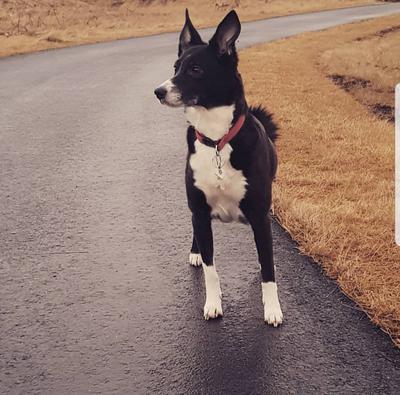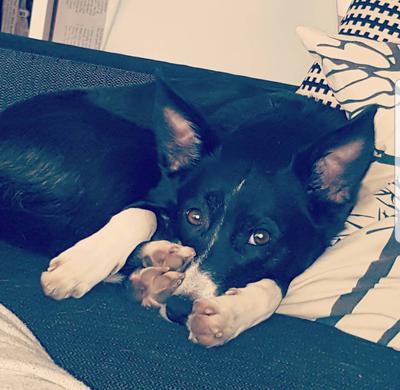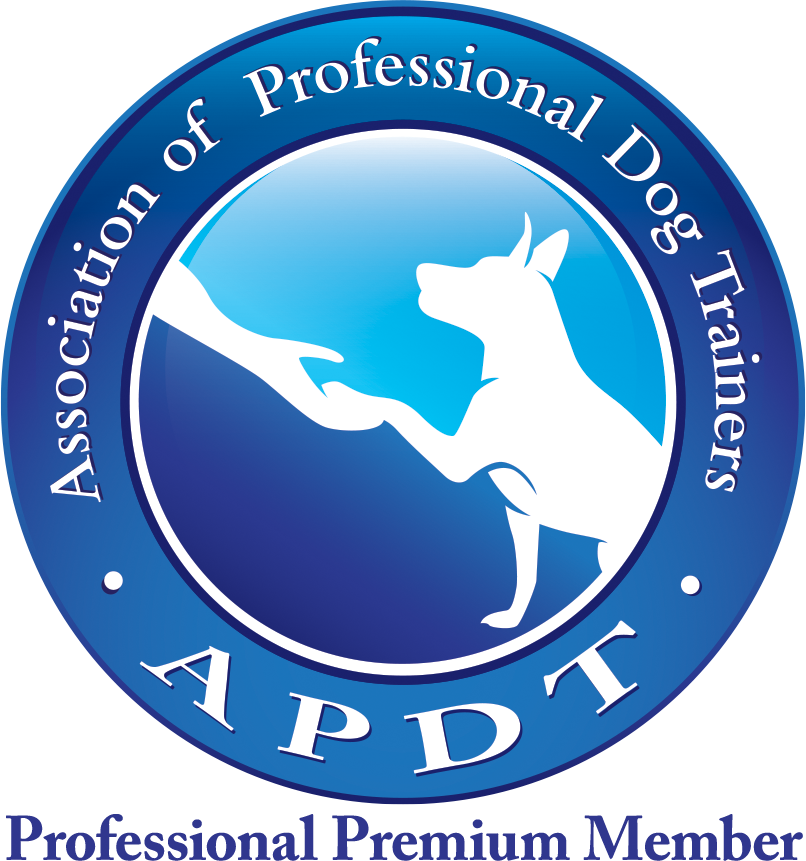Anxiety dog barking at guests, strangers and other dogs
by Elsa
(Reykjavik, Iceland)

Thunder
I have a dog that is bc/icelandic sheapdog/labrador mix named Þruma (Thunder). I got her when she was 4y/o but she will be 6y/o in May.
She has come a long way and is less stressed and more confident but I still have a big barking problem.
She barks at the doorbell and at guests but stops when she can smell them. What I wanted to ask is this;
Could it help if I told her to go to her bed and close the door (her bed is in the bedroom) so she can't see the guests and bark at them?
I have always chickened out because when I do that she won't stop barking. I could be in there with her till she calms down and let my boyfriend greet the guests. I'm wondering if this could help her see that she doesn't need to protect the home from something that terrifies her. And when she is calm she can come outside and meet the guests if she wants to.
Sorry for the long question but hopefully I will hear back from you :)
- Elsa and Thunder from Iceland
Answer
Hi Elsa!
Thank you for taking care of Thunder and caring about her fears. Anxiety and fearfulness in dogs is a little more complex than just trying to show her with your actions that something is not scary, specially if this problem has a long history.
I don’t think she will calm down if she is in the room because she will know there are “intruders” in her house, she may calm down a bit and then start barking again as soon as you open the door.
To treat fear and anxiety I usually recommend you work with your dog in 3 mayor areas:
- Basic obedience: This is important for you to learn how to communicate with Thunder in a way she will understand. You, as a human, will try to communicate…well, as a human. Which is very confusing for dogs. Learning positive training methods and teaching your dog several commands will open a channel of communication that will start relaxing Thunder. She will feel safer because now she can understand what you are asking. You can learn about the different
training methods and teach her some basic commands. - Relaxation: Dogs that suffer from anxiety and fear have a very difficult time relaxing. I have met many dogs that don’t even know how to relax and will go on until they pretty much pass-out out of exhaustion. Depending on how stressed you dog is, I would give her 7 stress-free days. Try not to have any guests, avoid any type of punishment (yelling, getting upset, etc.) and even make walks short if you think she is not enjoying them. Dogs that have chronic stress need at least 7 stress-free days to dissipate stress hormones. You can also spend time relaxing with her and give her treats when you see any sign of relaxation in he body, no matter how tiny it may seem.
- Work on the specific problems: Now that you have learned about dog training methods, have taught a few commands to your dog and can help her relax a little bit; it’s time to teach her that the door bell and strangers are not scary at all. Below are some articles that will help you create exercises to practice. Remember, never practice in a “real situation” (for example, when you have real guests), instead ask a friend to come by and help you start training your dog. This person’s job will be to come in the house, throw treats at your dog (even if she is barking!) leave and repeat. Repeat until you see Thunder starting to relax.
A few of the most important psychology concepts to understand are Classical conditioning, Desensitization and Counterconditioning. Read all of those articles to learn how slowly you need to work with your dog.
The slower you advance with Thunder, the faster she will learn. This is very counter intuitive but very true, so don’t try to rush it. Specially with a dog with such a long history of fear.
Other useful articles that will guide you when doing step 3 (exercises for specific problems):
- Fear Barking: This article will take you through all the steps to help Thunder ease her fears.
- Stress in dogs: This article will give you ideas to help your dog relax.
- Stop barking at the doorbell: This article takes you step-by-step to teach your dog to be quiet at the doorbell. I would do this one last (even though you might want to try it first) because your dog needs experience with training to succeed.
Hope this information helps! Please remember to never punish your dog because this will only make her fears worse. If you think things are getting out of hand, please contact a certified and positive dog trainer in your area. You can look for certified dog trainers in the Certification Council for Professional Dog Trainers.
Dog Trainer Nati.











